Meta Description
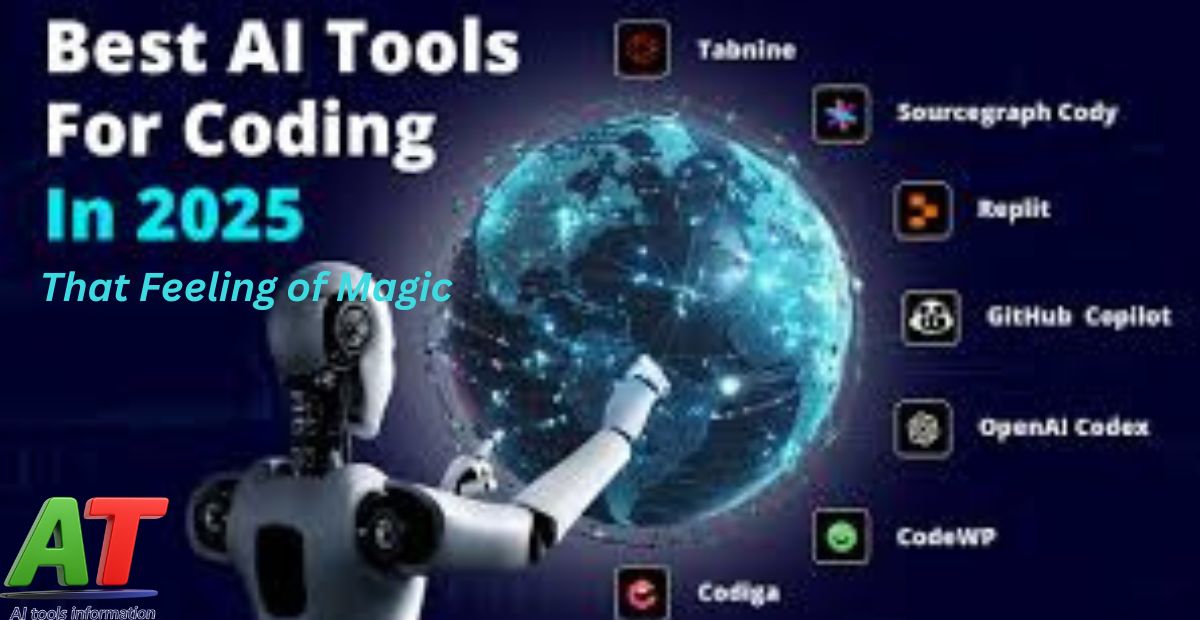
Discover the Top 10 AI Tools for Coding in 2025 to code faster, smarter, and error-free. Trusted by top developers in the US & UK. See what’s best for you!
As we explore the Top 10 ai tools for coding in 2025, you’ll find that these tools are revolutionizing the way coding is done.
1. Introduction
The AI coding revolution is no longer optional in 2025 — it’s essential. With AI tools now playing a central role in how developers write, debug, and optimize code, modern development workflows are evolving faster than ever. According to GitHub’s latest developer insights, over 60% of software developers in premium countries like the US, UK, and Canada are now integrating some form of AI support into their daily coding routines.
Utilizing the Top 10 ai tools for coding in 2025 enables developers to write code more effectively.
From real-time code completion to automated code suggestions and intelligent debugging assistants, AI-powered development environments are transforming how software is built. Whether you’re working on enterprise applications or solo projects, coding with artificial intelligence can drastically reduce manual effort and improve accuracy.
The Top 10 ai tools for coding in 2025 can greatly enhance productivity and streamline workflows.
With the Top 10 ai tools for coding in 2025, you can expect more intelligent suggestions and faster coding processes.
Overall, the Top 10 ai tools for coding in 2025 provide remarkable enhancements in coding efficiency.
In this blog, we’ll walk you through the 10 best AI coding tools for 2025 — highlighting features, pricing, and use cases. You’ll also learn about the rise of AI programming assistants, AI IDE tools, and neural network code generators that are making development faster and smarter across all skill levels.
Whether you’re exploring AI for software development, diving into machine learning tools for developers, or looking for advanced GPT-based coding tools, this guide is designed to help you make an informed, future-ready choice
2. Why Developers in Premium Markets Use AI Coding Tools
In premium tech markets like the United States, United Kingdom, Canada, Germany, and Australia, developers are under constant pressure to deliver high-quality code faster — without compromising security, maintainability, or scalability. The demand for smarter development workflows has made AI coding platforms an essential part of modern software engineering.
Key reasons AI coding tools are dominating these regions:
Many developers are excited about the Top 10 ai tools for coding in 2025 and their potential to simplify complex tasks.
- Productivity & Speed: With features like real-time code completion and AI automation for coding, developers can ship features and fix bugs in significantly less time. Time saved is revenue gained, especially for fast-moving startups and agile enterprise teams.
- Security & Clean Code: Tools like AI debugging assistants and automated code suggestions help detect issues early, improving code health and reducing vulnerabilities — a priority in compliance-heavy regions like the EU.
- Skill Augmentation, Not Replacement: In markets experiencing a tech talent shortage, AI acts as a pair programmer, empowering both junior and senior developers to write more reliable code, even in high-stakes environments.
- Support for Multiple Frameworks: Whether you’re building front-end UI or server-side APIs, tools now support AI for front-end and back-end development, giving full-stack devs an all-in-one productivity boost.
- Enterprise Adoption: Large organizations are investing in AI IDE tools that support team collaboration, enterprise security, and role-based access. AI is no longer a luxury — it’s a budgeted line item in IT strategy.
Recent surveys by GitHub and Stack Overflow also highlight that developers using AI code generators are not only faster but also report higher job satisfaction, thanks to the reduced mental load and better work-life balance.
3. Key Factors to Consider Before Choosing an AI Coding Tool
Evaluate how the Top 10 ai tools for coding in 2025 align with your specific coding needs.
With dozens of options available in 2025, selecting the right AI tool isn’t just about hype — it’s about matching features to your development workflow. Whether you’re looking for AI tools for Python developers or enterprise-ready platforms, here are the essential criteria to evaluate:
✅ Language Support
Ensure the tool supports your primary programming languages — such as Python, JavaScript, Java, or C++. Some tools, like AI-powered code editors, offer broader multi-language support, while others specialize in specific stacks.
✅ IDE Integration

Each of the Top 10 ai tools for coding in 2025 offers unique features designed to suit different developers.
Seamless integration with popular IDEs like Visual Studio Code, JetBrains, or IntelliJ ensures you don’t have to switch environments. Look for tools that plug directly into your existing setup.
✅ Real-Time Suggestions & Accuracy
Accuracy is everything. Top tools now offer automated code suggestions with near-human fluency, minimizing the need for manual correction. This is especially useful in large-scale environments with high output demands.
✅ Security & Data Privacy
In premium regions like the EU and UK, data compliance (e.g., GDPR) is mandatory. Prioritize tools that ensure code isn’t used to train external models without consent and offer enterprise-grade data encryption.
✅ Cost & Enterprise Licensing
Some tools are free for individual use but require payment for team or commercial applications. Always review licensing terms if you’re integrating into a larger org or distributing software externally.
✅ Team Collaboration Features
Advanced tools now offer AI pair programming and team workflows — where AI adapts to shared codebases, version control systems, and team coding standards.
The emergence of the Top 10 ai tools for coding in 2025 is reshaping the software development landscape.
✅ Customer Support & Documentation
Premium tools offer real-time support, onboarding, and rich documentation. This is vital for teams who want to scale quickly with minimal disruption.
4. Top 10 Best AI Tools for Coding in 2025
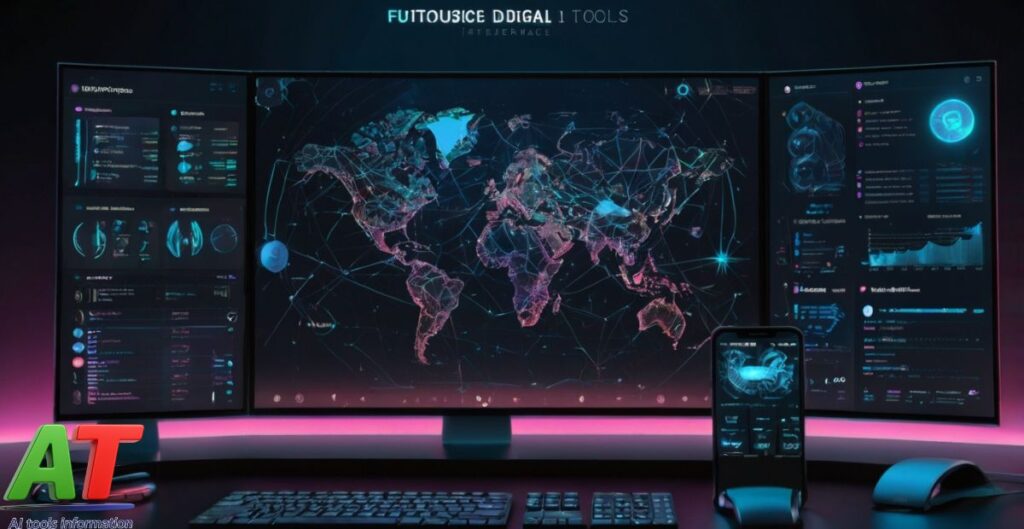
Here’s a curated list of the top-performing AI tools developers trust in 2025 — from solo coders to enterprise engineering teams. Whether you’re exploring GPT-based coding tools or lightweight AI IDE tools, these options cover every skill level and development need.
1. GitHub Copilot
Summary: Developed by GitHub and OpenAI, Copilot continues to lead the way as a robust AI pair programmer, helping developers write entire code blocks with minimal prompts.
Key Features:
- Context-aware code completion
- Supports most major programming languages
- Integrated with VS Code and JetBrains IDEs
Ideal For: Intermediate to advanced developers
Pricing: Paid only; starts at $10/month
Pros: High accuracy, deep GitHub repo learning Cons: No free tier
For those looking to optimize their workflow, the Top 10 ai tools for coding in 2025 are an excellent choice.
👉 Try GitHub Copilot → copilot.github.com
2. Amazon CodeWhisperer
Summary: A reliable choice for AWS-based teams, CodeWhisperer brings AI automation for coding into cloud-first workflows.
Key Features:
- Deep integration with AWS services
- Supports Python, Java, JavaScript, and more
- Emphasizes secure code recommendations
Ideal For: Backend developers, enterprise teams
Pricing: Free individual tier; Pro and Enterprise plans available
Pros: Great AWS synergy Cons: Limited to Amazon ecosystem
3. Tabnine
Summary: Tabnine stands out among AI code generators for its lightweight design and real-time predictive suggestions that work right inside your IDE.
Key Features:
- Trains models locally for privacy
- Real-time suggestions without latency
- Supports dozens of languages
Ideal For: Freelancers, privacy-focused devs
Pricing: Free for individuals; premium plans available
Pros: Fast and private Cons: Slightly less accurate for complex logic
4. Codeium
Summary: A rising star in 2025, Codeium offers powerful, free AI in software engineering support for multiple languages and frameworks.
Key Features:
- Multilingual support with rich IDE plugins
In conclusion, the Top 10 ai tools for coding in 2025 are essential for modern software development.
- Syntax-aware and fast
- Designed for solo and team workflows
Ideal For: Beginners, budget-conscious teams
Pricing: Completely free
Pros: No paywall, generous features Cons: Early-stage bugs in some integrations
5. Replit Ghostwriter
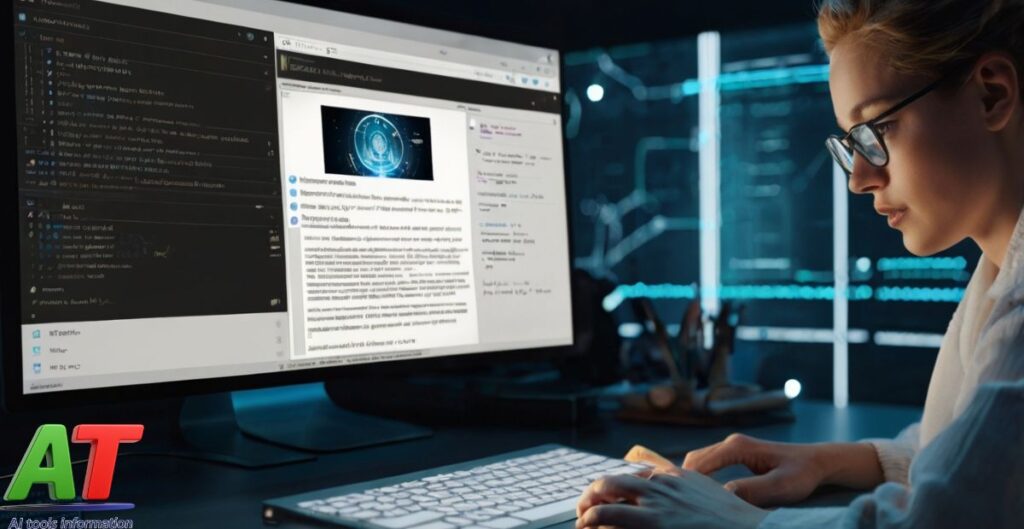
Summary: Replit’s Ghostwriter is an excellent choice for those interested in coding with artificial intelligence in an online, collaborative setting.
Key Features:
- Built into the Replit IDE
- Instant feedback and debugging
- Collaborative editing
Ideal For: Students, teams working remotely
Pricing: Included in Replit Pro ($20/month)
Pros: Great for learning and collaboration Cons: Less customizable for pro devs
6. Mutable.ai
Summary: Known for code optimization with AI, Mutable.ai helps devs refactor, auto-document, and speed up delivery with automation.
Key Features:
- Automatic documentation generation
- One-click refactoring
- Supports multiple frameworks
Ideal For: Full-stack developers
Pricing: Free tier + paid plans
Pros: Automation-focused Cons: May struggle with custom architectures
7. Codiga
Summary: Codiga offers real-time automated code suggestions and helps enforce best practices through smart code review and linting.
Key Features:
- Smart snippets and static analysis
- Supports GitHub, GitLab, Bitbucket
- Security rule enforcement
Ideal For: Teams, CI/CD environments
Pricing: Free tier with advanced plans
Pros: Ideal for code quality Cons: Less useful for solo developers
8. Sourcery
Summary: Sourcery is purpose-built for Python and stands out among AI tools for Python developers by automating refactoring and readability improvements.
Key Features:
- Python-specific refactor suggestions
- VS Code and PyCharm support
- Clear, readable suggestions
Ideal For: Python-focused devs
Pricing: Free for individuals
Pros: Python expertise Cons: Python-only focus
9. DeepCode (by Snyk)
Summary: DeepCode functions as an advanced AI debugging assistant, analyzing code for complex bugs and potential vulnerabilities.
Key Features:
- Security-first code analysis
- Fast scan engine
- Real-time feedback in IDE
Ideal For: Enterprise security teams
Pricing: Included with Snyk plans
Pros: Security + AI = win Cons: Limited to certain languages
10. Kite (Legacy)
Summary: Though now sunset, Kite helped set the standard for AI-powered code editors with its slick Python completions — influencing tools we now rely on.
Legacy Contribution:
- Brought machine learning tools for developers into mainstream
- Inspired lighter, faster completions with ML inference
- Popularized on-device coding intelligence
Note: As of late 2024, Kite is no longer actively maintained but worth mentioning historically.
Perfect — here’s Section 5: Comparison Table: AI Coding Tools (Side-by-Side) presented in a clear, easy-to-read format:
5. Comparison Table: AI Coding Tools (Side-by-Side)
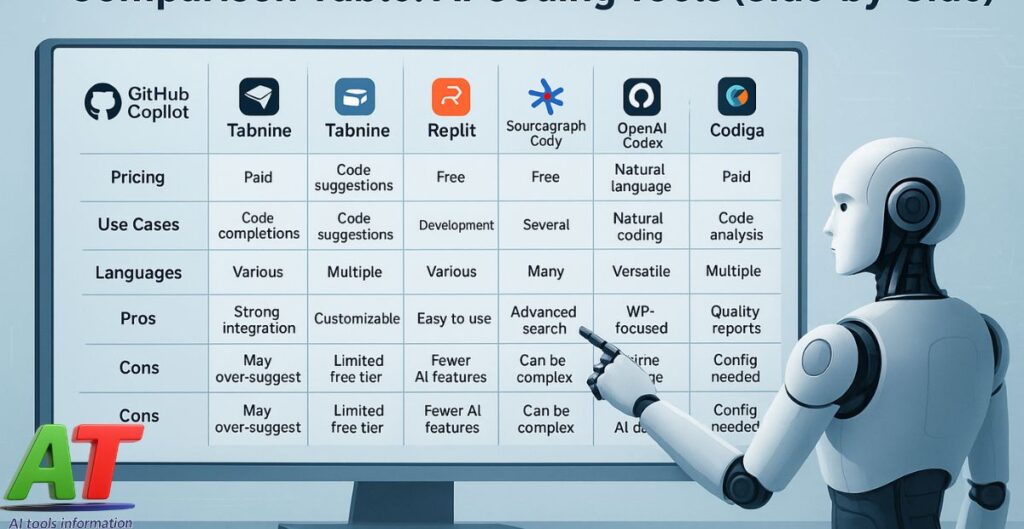
| Tool Name | Best For | Languages Supported | Free Plan | IDE Integration | Security Features |
| GitHub Copilot | Pro developers | Python, JS, TypeScript, etc. | ❌ | VS Code, JetBrains | GitHub Security/PR filtering |
| CodeWhisperer | AWS ecosystem developers | Python, Java, JS, C#, more | ✅ | VS Code, JetBrains | IAM identity & code safety scoring |
| Tabnine | Freelancers & startups | 20+ languages | ✅ | All major IDEs | On-device model option |
| Codeium | Beginners, teams | Python, JS, Java, etc. | ✅ | VS Code, JetBrains, more | No-code logging, private repos |
| Ghostwriter | Remote & student teams | Python, JS, HTML/CSS | ❌ | Replit IDE | Sandboxed environment |
| Mutable.ai | Full-stack developers | JavaScript, Python, TS | ✅ | VS Code, Jupyter Notebooks | Local-only option in paid tier |
| Codiga | Code quality reviewers | JS, Python, Java, SQL | ✅ | VS Code, IntelliJ, CI tools | Custom security rules |
| Sourcery | Python-only projects | Python | ✅ | PyCharm, VS Code | Readability-focused ruleset |
| DeepCode (Snyk) | Security engineers | Java, JS, Python, more | ✅ | JetBrains, VS Code | Real-time vulnerability scans |
| Kite (Legacy) | Python coders (historical) | Python | ✅ (Legacy) | VS Code, Atom (historical) | On-device, no data sharing |
6. Use Case Breakdown: Which Tool is Right for You?
✅ Tip: For teams working across multiple languages, Tabnine or Codeium offer excellent flexibility. For Python specialists, Sourcery or the now-defunct Kite may still hold value in archived projects.
Choosing the right AI coding tool depends heavily on your role, team size, and tech stack. Here’s a breakdown to help you find the best match for your needs — whether you’re a student just starting out or an enterprise-level engineer handling massive deployments.
6. Use Case Breakdown: Which Tool is Right for You?
👨💻 Freelance Developers
Recommended Tool: Tabnine Freelancers need fast, lightweight tools that boost productivity without locking them into enterprise pricing. Tabnine offers strong autocomplete capabilities, privacy-conscious local models, and broad language support.
Why it fits: Low cost, fast setup, works well across multiple IDEs.
🚀 Startup Teams
Recommended Tool: Codeium Startup developers wear many hats. Codeium offers flexible support for multiple languages, generous free-tier access, and excellent speed — all without the enterprise-level complexity.
Why it fits: Free, fast, collaborative, and easy to integrate into CI/CD pipelines.
🏢 Enterprise Software Engineers
Recommended Tool: Amazon CodeWhisperer Built with AWS security and scalability in mind, CodeWhisperer integrates with IAM policies, provides automated code suggestions, and aligns well with regulated environments.
Why it fits: Enterprise-grade controls, multi-language support, AWS-native design.
👩🎓 Students & New Coders
Recommended Tool: Replit Ghostwriter For learners, AI programming assistants that work in browser-based environments are perfect. Ghostwriter helps students code, debug, and learn collaboratively in real time.
Why it fits: Built into a beginner-friendly IDE with interactive feedback.
🌐 Remote & Collaborative Teams
Recommended Tool: GitHub Copilot Distributed teams benefit from Copilot’s contextual intelligence and tight GitHub integration. It acts like an AI IDE tool that understands your repo, PRs, and team patterns.
Why it fits: Best-in-class code prediction, team-aware learning, seamless devops workflow.
💻 Python-Centric Projects
Recommended Tool: Sourcery Python teams looking to optimize code readability and structure should turn to Sourcery. It’s a dedicated AI tool for Python developers that handles refactoring with precision.
Why it fits: Python-first design, intelligent improvements, simple pricing.
🔐 Security-Driven Teams
Recommended Tool: DeepCode by Snyk Security is mission-critical for certain industries. DeepCode helps identify vulnerabilities early using neural network code generators trained on safe, vetted patterns.
Why it fits: Deep analysis, actionable insights, integrates well with CI and PR reviews.
📌 Quick Tip: If you’re unsure, start with a free-tier tool like Codeium or Tabnine and benchmark performance over 1–2 sprints before committing.
7. The Limitations & Ethical Considerations
While AI coding tools offer impressive productivity gains, they aren’t without risks. Relying on AI in software engineering introduces a range of limitations, ethical concerns, and compliance questions — especially in countries with strict data privacy laws like Germany and the UK.
Here’s what developers and organizations need to watch for:
⚠️ 1. Insecure or Biased Code Suggestions
AI models learn from public datasets, which may include insecure or outdated coding patterns. This means AI-generated solutions could introduce bugs or vulnerabilities into production code — especially in sensitive sectors like finance or healthcare.
Example: An AI code generator might suggest a deprecated authentication method if it’s statistically more common in the training set.
🧠 2. Over-Reliance Can Stunt Learning
New coders may skip foundational learning by relying too heavily on suggestions. Tools like AI debugging assistants are great for productivity, but should complement — not replace — your critical thinking and problem-solving skills.
🛡️ 3. Data Privacy & Compliance Risks
In EU countries like Germany, GDPR rules strictly regulate how data is used. If your AI-powered code editor sends snippets to the cloud, you could unknowingly expose proprietary information or violate data laws.
Tip: Prefer tools offering on-device or anonymized models, especially for regulated industries.
🤖 4. Lack of Context or Domain Understanding
Even advanced GPT-based coding tools lack true contextual awareness. They may not understand your business rules, internal libraries, or team-specific architecture — leading to irrelevant or inefficient code.
🔄 5. Ownership & Licensing Ambiguity
If an AI suggests code derived from open-source datasets, there could be intellectual property concerns. It’s unclear in some cases whether the output is truly original or derivative.
Consider: Establish internal guidelines for using AI in mission-critical or client-facing projects.
In short, while AI in software engineering is powerful, it’s not a silver bullet. Responsible adoption means understanding its limitations and putting guardrails in place — both technically and ethically.
8. Future of AI Coding Tools: What’s Coming in 2026+
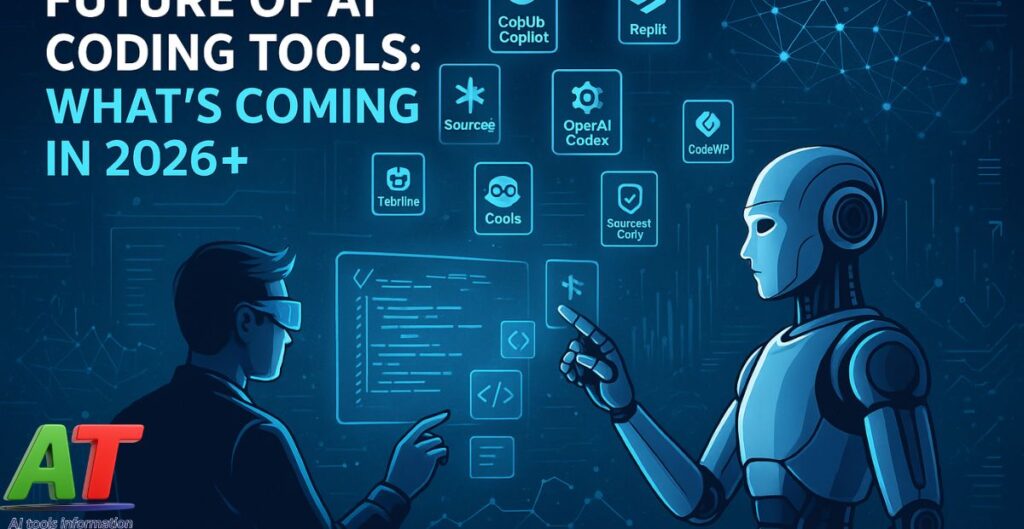
The AI revolution in coding is accelerating, and 2026 promises even more transformative advances for developers worldwide — especially in premium markets where innovation drives competitive advantage.
🔮 1. More Human-AI Pair Programming
AI will evolve from simple code suggestion tools into true collaborators. Expect more sophisticated AI pair programmers that learn your coding style, suggest architectural improvements, and even review code for logical consistency in real time.
🛠️ 2. No-Code & Low-Code AI Platforms
The rise of AI automation for coding will empower non-developers to build applications using natural language commands and AI-generated components. This democratizes software development but will still require expert oversight.
⚙️ 3. Custom & Enterprise AI Models
Enterprises will increasingly train their own AI models on proprietary codebases, ensuring automated code suggestions are fully compliant with internal standards and security policies — solving today’s concerns around data privacy and licensing.
🚀 4. Integration of Neural Network Code Generators with DevOps
Neural network code generators will tightly integrate with CI/CD pipelines, automating testing, bug fixes, and even deployment workflows — reducing manual intervention and accelerating release cycles.
🌐 5. Advanced AI for Front-End and Back-End Development
AI tools will become better at understanding full-stack development — seamlessly supporting AI for front-end and back-end development. This means smarter UI/UX suggestions, database schema optimizations, and more robust APIs generated by AI.
🤝 6. Ethical AI Frameworks & Regulations
As AI adoption grows, expect clearer regulations, especially around data usage, bias, and code ownership. Developers and organizations will need to adopt ethical AI frameworks to build trust and ensure compliance.
In short, the future points to an era where AI tools are deeply embedded in every step of the software lifecycle — not just coding, but design, testing, deployment, and maintenance.
9. Final Thoughts & Recommendations
As AI continues to reshape software development in 2025 and beyond, choosing the right best AI coding tools 2025 is crucial to staying competitive and efficient. From freelance developers to enterprise teams, there’s an AI solution tailored for every workflow.
Key Takeaways:
- GitHub Copilot and Amazon CodeWhisperer lead for professional and enterprise use, offering deep integrations and powerful AI assistance.
- Freelancers and startups will find Tabnine and Codeium appealing for their flexible pricing and broad language support.
- Students and learners can benefit immensely from browser-based solutions like Replit Ghostwriter that foster collaboration and rapid feedback.
- For Python developers, dedicated tools like Sourcery provide specialized refactoring and code optimization with AI.
- Always consider security, privacy, and compliance when adopting AI tools, especially in regulated premium markets.
Final advice: Start small by experimenting with free tiers or trials. Measure how much each tool improves your productivity and code quality before scaling usage. And remember — AI is a powerful partner, but your expertise remains irreplaceable.
10. FAQs: Best AI Tools for Coding (2025)
Q1: What is the most accurate Ai tools for coding
A: GitHub Copilot is widely regarded as the most accurate AI pair programmer in 2025, thanks to its deep integration with GitHub’s vast code repositories and real-time context awareness.
Q2: Are AI coding tools safe for professional use?
A: Yes, many AI programming assistants like Amazon CodeWhisperer and DeepCode follow strict security protocols and support enterprise-grade compliance. However, developers should always review AI-generated code for potential vulnerabilities.
Q3: Can I use the best AI coding tools for free?
A: Several tools such as Tabnine, Codeium, and Sourcery offer free tiers suitable for individual developers or small teams. For advanced features and enterprise use, paid plans are usually required.
Q4: Which AI tool works best with Python?
A: Sourcery is a dedicated AI tool for Python developers offering precise refactoring and code improvements. Additionally, GitHub Copilot and Amazon CodeWhisperer also provide strong Python support.
Q5: Will AI replace developers in the future?
A: AI is designed to augment developers, not replace them. Tools like GPT-based coding tools enhance productivity by automating repetitive tasks, but human expertise remains critical for complex problem-solving and creative software engineering.
Ultimately, leveraging the Top 10 ai tools for coding in 2025 will future-proof your coding endeavors.
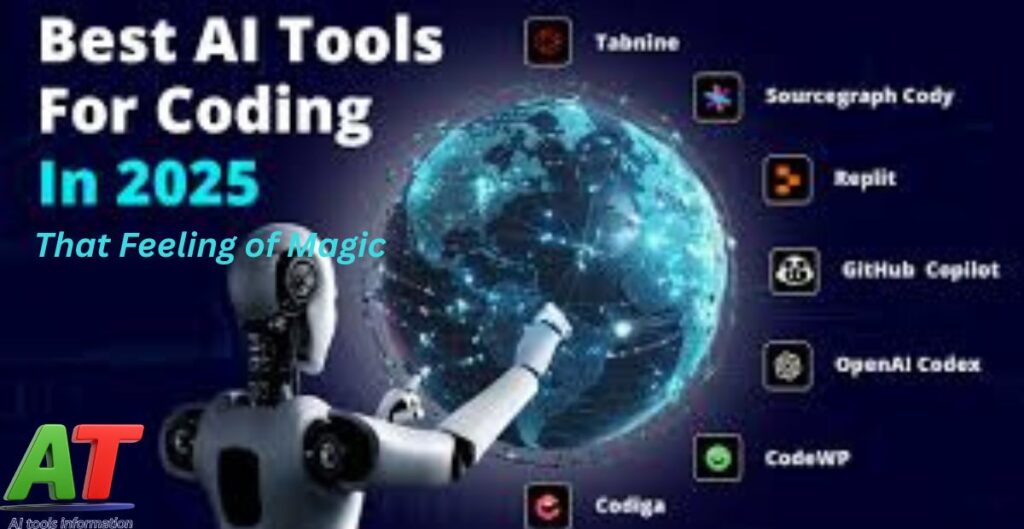

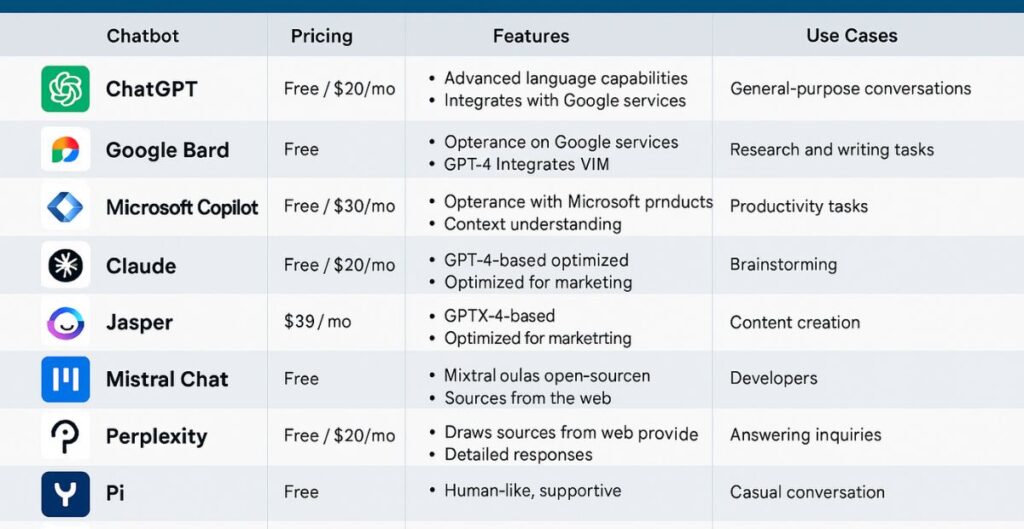
Pingback: Top 10 Best Free AI Tools for Medical Codes Mapping
Pingback: 120 Mind Blowing AI Tools to Supercharge Your Work in 2025